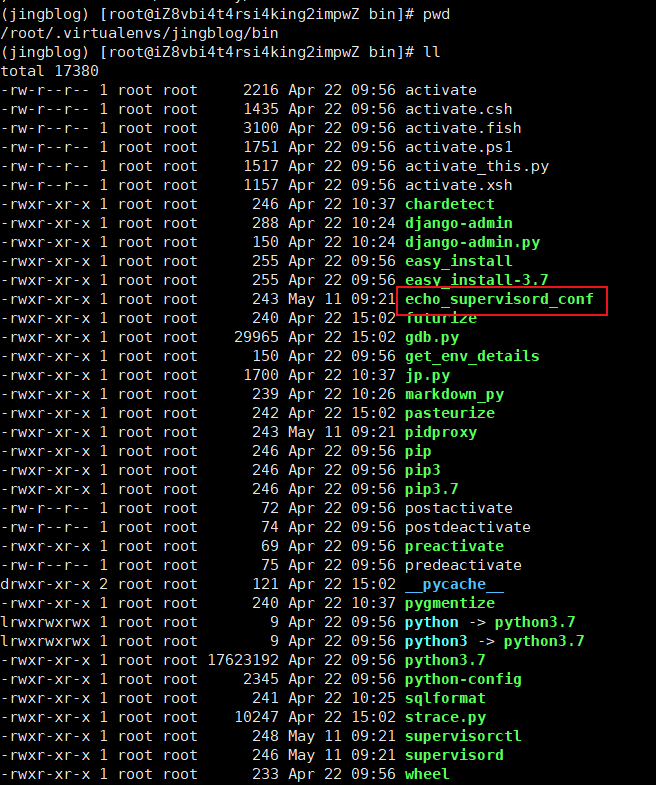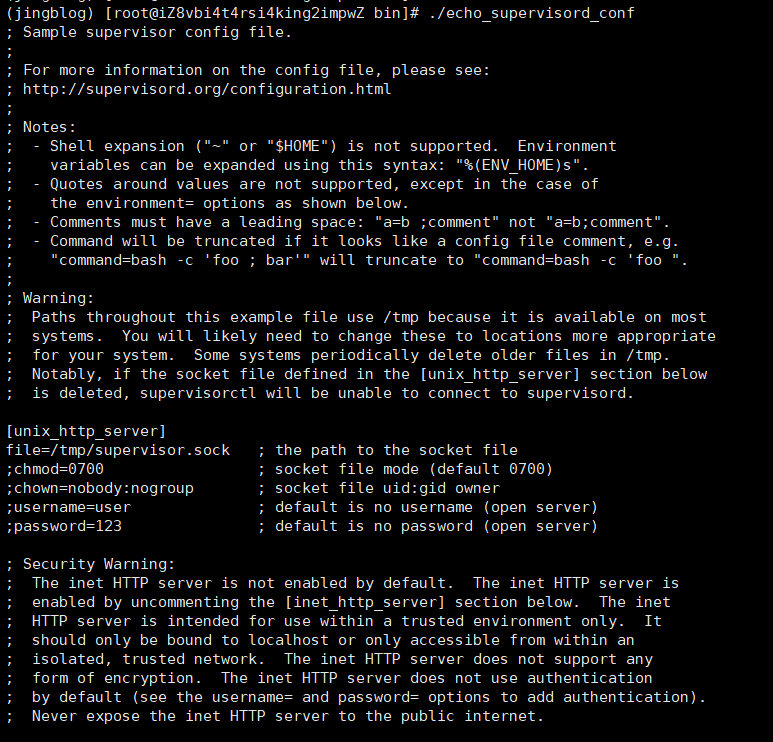一、简介
Supervisor(http://supervisord.org) 是用 Python 开发的一个 C/S 服务。是 Linux/Unix 系统下的进程管理工具。它可以很方便的监听、启动、停止、重启一个或多个进程。用Supervisor管理的进程,当一个进程意外被杀死,supervisort监听到进程死后,会自动将它重新拉起,很方便的做到进程自动恢复的功能,不再需要自己写shell脚本来控制。
supervisord 运行Supervisor时会启动一个进程supervisord,它负责启动所管理的进程,并将所管理的进程作为自己的子进程来启动,而且可以在所管理的进程出现崩溃时自动重启。
supervisorctl 是命令行管理工具,可以用来执行 stop、start、restart 等命令,来对这些子进程进行管理。
supervisor是所有进程的父进程,管理着启动的子进展,supervisor以子进程的PID来管理子进程,当子进程异常退出时supervisor可以收到相应的信号量。
二、安装
1:通过pip安装
pip install supervisor
2:检查是否安装成功
安装路径:/root/.virtualenvs/jingblog/bin(我是在虚拟环境下安装的)

执行echo_supervisord_conf

三、Hello Supervisor
1:创建目录,初始化配置文件
mkdir /usr/supervisor
echo_supervisord_conf > /usr/supervisor/supervisord.conf
echo_supervisord_conf详解

; Sample supervisor config file. ; ; For more information on the config file, please see: ; http://supervisord.org/configuration.html ; ; Notes: ; - Shell expansion ("~" or "$HOME") is not supported. Environment ; variables can be expanded using this syntax: "%(ENV_HOME)s". ; - Quotes around values are not supported, except in the case of ; the environment= options as shown below. ; - Comments must have a leading space: "a=b ;comment" not "a=b;comment". ; - Command will be truncated if it looks like a config file comment, e.g. ; "command=bash -c 'foo ; bar'" will truncate to "command=bash -c 'foo ". ; ; Warning: ; Paths throughout this example file use /tmp because it is available on most ; systems. You will likely need to change these to locations more appropriate ; for your system. Some systems periodically delete older files in /tmp. ; Notably, if the socket file defined in the [unix_http_server] section below ; is deleted, supervisorctl will be unable to connect to supervisord. [unix_http_server] file=/tmp/supervisor.sock ; the path to the socket file ;chmod=0700 ; socket file mode (default 0700) ;chown=nobody:nogroup ; socket file uid:gid owner ;username=user ; default is no username (open server) ;password=123 ; default is no password (open server) ; Security Warning: ; The inet HTTP server is not enabled by default. The inet HTTP server is ; enabled by uncommenting the [inet_http_server] section below. The inet ; HTTP server is intended for use within a trusted environment only. It ; should only be bound to localhost or only accessible from within an ; isolated, trusted network. The inet HTTP server does not support any ; form of encryption. The inet HTTP server does not use authentication ; by default (see the username= and password= options to add authentication). ; Never expose the inet HTTP server to the public internet. [inet_http_server] ; inet (TCP) server disabled by default port=0:9001 ; ip_address:port specifier, *:port for all iface username=user ; default is no username (open server) password=123 ; default is no password (open server) [supervisord] logfile=/tmp/supervisord.log ; main log file; default $CWD/supervisord.log logfile_maxbytes=50MB ; max main logfile bytes b4 rotation; default 50MB logfile_backups=10 ; # of main logfile backups; 0 means none, default 10 loglevel=info ; log level; default info; others: debug,warn,trace pidfile=/tmp/supervisord.pid ; supervisord pidfile; default supervisord.pid nodaemon=false ; start in foreground if true; default false silent=false ; no logs to stdout if true; default false minfds=1024 ; min. avail startup file descriptors; default 1024 minprocs=200 ; min. avail process descriptors;default 200 ;umask=022 ; process file creation umask; default 022 ;user=supervisord ; setuid to this UNIX account at startup; recommended if root ;identifier=supervisor ; supervisord identifier, default is 'supervisor' ;directory=/tmp ; default is not to cd during start ;nocleanup=true ; don't clean up tempfiles at start; default false ;childlogdir=/tmp ; 'AUTO' child log dir, default $TEMP ;environment=KEY="value" ; key value pairs to add to environment ;strip_ansi=false ; strip ansi escape codes in logs; def. false ; The rpcinterface:supervisor section must remain in the config file for ; RPC (supervisorctl/web interface) to work. Additional interfaces may be ; added by defining them in separate [rpcinterface:x] sections. [rpcinterface:supervisor] supervisor.rpcinterface_factory = supervisor.rpcinterface:make_main_rpcinterface ; The supervisorctl section configures how supervisorctl will connect to ; supervisord. configure it match the settings in either the unix_http_server ; or inet_http_server section. [supervisorctl] serverurl=unix:///tmp/supervisor.sock ; use a unix:// URL for a unix socket ;serverurl=http://127.0.0.1:9001 ; use an http:// url to specify an inet socket ;username=chris ; should be same as in [*_http_server] if set ;password=123 ; should be same as in [*_http_server] if set ;prompt=mysupervisor ; cmd line prompt (default "supervisor") ;history_file=~/.sc_history ; use readline history if available ; The sample program section below shows all possible program subsection values. ; Create one or more 'real' program: sections to be able to control them under ; supervisor. ;[program:theprogramname] ;command=/bin/cat ; the program (relative uses PATH, can take args) ;process_name=%(program_name)s ; process_name expr (default %(program_name)s) ;numprocs=1 ; number of processes copies to start (def 1) ;directory=/tmp ; directory to cwd to before exec (def no cwd) ;umask=022 ; umask for process (default None) ;priority=999 ; the relative start priority (default 999) ;autostart=true ; start at supervisord start (default: true) ;startsecs=1 ; # of secs prog must stay up to be running (def. 1) ;startretries=3 ; max # of serial start failures when starting (default 3) ;autorestart=unexpected ; when to restart if exited after running (def: unexpected) ;exitcodes=0 ; 'expected' exit codes used with autorestart (default 0) ;stopsignal=QUIT ; signal used to kill process (default TERM) ;stopwaitsecs=10 ; max num secs to wait b4 SIGKILL (default 10) ;stopasgroup=false ; send stop signal to the UNIX process group (default false) ;killasgroup=false ; SIGKILL the UNIX process group (def false) ;user=chrism ; setuid to this UNIX account to run the program ;redirect_stderr=true ; redirect proc stderr to stdout (default false) ;stdout_logfile=/a/path ; stdout log path, NONE for none; default AUTO ;stdout_logfile_maxbytes=1MB ; max # logfile bytes b4 rotation (default 50MB) ;stdout_logfile_backups=10 ; # of stdout logfile backups (0 means none, default 10) ;stdout_capture_maxbytes=1MB ; number of bytes in 'capturemode' (default 0) ;stdout_events_enabled=false ; emit events on stdout writes (default false) ;stdout_syslog=false ; send stdout to syslog with process name (default false) ;stderr_logfile=/a/path ; stderr log path, NONE for none; default AUTO ;stderr_logfile_maxbytes=1MB ; max # logfile bytes b4 rotation (default 50MB) ;stderr_logfile_backups=10 ; # of stderr logfile backups (0 means none, default 10) ;stderr_capture_maxbytes=1MB ; number of bytes in 'capturemode' (default 0) ;stderr_events_enabled=false ; emit events on stderr writes (default false) ;stderr_syslog=false ; send stderr to syslog with process name (default false) ;environment=A="1",B="2" ; process environment additions (def no adds) ;serverurl=AUTO ; override serverurl computation (childutils) ; The sample eventlistener section below shows all possible eventlistener ; subsection values. Create one or more 'real' eventlistener: sections to be ; able to handle event notifications sent by supervisord. ;[eventlistener:theeventlistenername] ;command=/bin/eventlistener ; the program (relative uses PATH, can take args) ;process_name=%(program_name)s ; process_name expr (default %(program_name)s) ;numprocs=1 ; number of processes copies to start (def 1) ;events=EVENT ; event notif. types to subscribe to (req'd) ;buffer_size=10 ; event buffer queue size (default 10) ;directory=/tmp ; directory to cwd to before exec (def no cwd) ;umask=022 ; umask for process (default None) ;priority=-1 ; the relative start priority (default -1) ;autostart=true ; start at supervisord start (default: true) ;startsecs=1 ; # of secs prog must stay up to be running (def. 1) ;startretries=3 ; max # of serial start failures when starting (default 3) ;autorestart=unexpected ; autorestart if exited after running (def: unexpected) ;exitcodes=0 ; 'expected' exit codes used with autorestart (default 0) ;stopsignal=QUIT ; signal used to kill process (default TERM) ;stopwaitsecs=10 ; max num secs to wait b4 SIGKILL (default 10) ;stopasgroup=false ; send stop signal to the UNIX process group (default false) ;killasgroup=false ; SIGKILL the UNIX process group (def false) ;user=chrism ; setuid to this UNIX account to run the program ;redirect_stderr=false ; redirect_stderr=true is not allowed for eventlisteners ;stdout_logfile=/a/path ; stdout log path, NONE for none; default AUTO ;stdout_logfile_maxbytes=1MB ; max # logfile bytes b4 rotation (default 50MB) ;stdout_logfile_backups=10 ; # of stdout logfile backups (0 means none, default 10) ;stdout_events_enabled=false ; emit events on stdout writes (default false) ;stdout_syslog=false ; send stdout to syslog with process name (default false) ;stderr_logfile=/a/path ; stderr log path, NONE for none; default AUTO ;stderr_logfile_maxbytes=1MB ; max # logfile bytes b4 rotation (default 50MB) ;stderr_logfile_backups=10 ; # of stderr logfile backups (0 means none, default 10) ;stderr_events_enabled=false ; emit events on stderr writes (default false) ;stderr_syslog=false ; send stderr to syslog with process name (default false) ;environment=A="1",B="2" ; process environment additions ;serverurl=AUTO ; override serverurl computation (childutils) ; The sample group section below shows all possible group values. Create one ; or more 'real' group: sections to create "heterogeneous" process groups. ;[group:thegroupname] ;programs=progname1,progname2 ; each refers to 'x' in [program:x] definitions ;priority=999 ; the relative start priority (default 999) ; The [include] section can just contain the "files" setting. This ; setting can list multiple files (separated by whitespace or ; newlines). It can also contain wildcards. The filenames are ; interpreted as relative to this file. Included files *cannot* ; include files themselves. [include] files = /usr/supervisor/supervisord.d/*.conf
2:为了不将所有新增配置信息全写在一个配置文件里,这里新建一个文件夹
mkdir /usr/supervisor/supervisord.d/
3:修改系统配置文件
vim /usr/supervisor/supervisord.conf
3.1 include 2.1中新建的supervisord.d文件夹下所有的conf
[include] files = /usr/supervisor/supervisord.d/*.conf
3.2 若需要web查看进程,则去掉[inet_http_server]的注释,并修改响应的ip配置
[inet_http_server] port=127.0.0.1:9001 ;IP按需配置 username=user password=123
4:如果是阿里云服务器,还需要开放9001端口

5:运行Supervisor
启动supervisord
supervisord -c /usr/supervisor/supervisord.conf
查看监听
lsof -i:9001

查看网页

四、配置Supervisor
1:添加一个配置文件,以便supervisor用来监控程序
cat > /usr/supervisor/supervisord.d/supervisor_project_myblogs.conf

- command:启动程序使用的命令,可以是绝对路径或者相对路径 - process_name:一个python字符串表达式,用来表示supervisor进程启动的这个的名称,默认值是%(program_name)s - numprocs:Supervisor启动这个程序的多个实例,如果numprocs>1,则process_name的表达式必须包含%(process_num)s,默认是1 - numprocs_start:一个int偏移值,当启动实例的时候用来计算numprocs的值 - priority:权重,可以控制程序启动和关闭时的顺序,权重越低:越早启动,越晚关闭。默认值是999 - autostart:如果设置为true,当supervisord启动的时候,进程会自动重启。 - autorestart:值可以是false、true、unexpected。false:进程不会自动重启,unexpected:当程序退出时的退出码不是exitcodes中定义的时,进程会重启,true:进程会无条件重启当退出的时候。 - startsecs:程序启动后等待多长时间后才认为程序启动成功 - startretries:supervisord尝试启动一个程序时尝试的次数。默认是3 - exitcodes:一个预期的退出返回码,默认是0,2。 - stopsignal:当收到stop请求的时候,发送信号给程序,默认是TERM信号,也可以是 HUP, INT, QUIT, KILL, USR1, or USR2。 - stopwaitsecs:在操作系统给supervisord发送SIGCHILD信号时等待的时间 - stopasgroup:如果设置为true,则会使supervisor发送停止信号到整个进程组 - killasgroup:如果设置为true,则在给程序发送SIGKILL信号的时候,会发送到整个进程组,它的子进程也会受到影响。 - user:如果supervisord以root运行,则会使用这个设置用户启动子程序 - redirect_stderr:如果设置为true,进程则会把标准错误输出到supervisord后台的标准输出文件描述符。 - stdout_logfile:把进程的标准输出写入文件中,如果stdout_logfile没有设置或者设置为AUTO,则supervisor会自动选择一个文件位置。 - stdout_logfile_maxbytes:标准输出log文件达到多少后自动进行轮转,单位是KB、MB、GB。如果设置为0则表示不限制日志文件大小 - stdout_logfile_backups:标准输出日志轮转备份的数量,默认是10,如果设置为0,则不备份 - stdout_capture_maxbytes:当进程处于stderr capture mode模式的时候,写入FIFO队列的最大bytes值,单位可以是KB、MB、GB - stdout_events_enabled:如果设置为true,当进程在写它的stderr到文件描述符的时候,PROCESS_LOG_STDERR事件会被触发 - stderr_logfile:把进程的错误日志输出一个文件中,除非redirect_stderr参数被设置为true - stderr_logfile_maxbytes:错误log文件达到多少后自动进行轮转,单位是KB、MB、GB。如果设置为0则表示不限制日志文件大小 - stderr_logfile_backups:错误日志轮转备份的数量,默认是10,如果设置为0,则不备份 - stderr_capture_maxbytes:当进程处于stderr capture mode模式的时候,写入FIFO队列的最大bytes值,单位可以是KB、MB、GB - stderr_events_enabled:如果设置为true,当进程在写它的stderr到文件描述符的时候,PROCESS_LOG_STDERR事件会被触发 - environment:一个k/v对的list列表 - directory:supervisord在生成子进程的时候会切换到该目录 - umask:设置进程的umask - serverurl:是否允许子进程和内部的HTTP服务通讯,如果设置为AUTO,supervisor会自动的构造一个url

[program:myblogs] command=python3 manage.py runserver 0:8089 ; 被监控的进程启动命令 directory=/opt/project/jblog/myblogs ; 执行前要不要先cd到目录去,一般不用 priority=1 ;数字越高,优先级越高 numprocs=1 ; 启动几个进程 autostart=true ; 随着supervisord的启动而启动 autorestart=true ; 自动重启。。当然要选上了 startretries=10 ; 启动失败时的最多重试次数 exitcodes=0 ; 正常退出代码(是说退出代码是这个时就不再重启了吗?待确定) stopsignal=KILL ; 用来杀死进程的信号 stopwaitsecs=10 ; 发送SIGKILL前的等待时间 redirect_stderr=true ; 重定向stderr到stdout
2:重启supervisor
supervisorctl -c /usr/supervisor/supervisord.conf
reload

现在就可以在http://ip:9001/中访问test_one的程序了。

3:测试
找到8089端口对应的进程
lsof -i:8089
杀死

五、Supervisor开机自动启动
1:在目录/usr/lib/systemd/system/ 新建文件supervisord.service,并添加配置内容

[Unit] Description=Process Monitoring and Control Daemon After=rc-local.service nss-user-lookup.target [Service] Type=forking ExecStart=/usr/bin/supervisord -c /usr/supervisor/supervisord.conf ;开机启动时执行 ExecStop=/usr/bin/supervisord shutdown ExecReload=/usr/bin/supervisord reload killMode=process Restart=on-failure RestartSec=42s [Install] WantedBy=multi-user.target
2:启动服务
systemctl enable supervisord
3:验证一下是否为开机启动
systemctl is-enabled supervisord
六、Supervisor周边
1:常用命令

[root@iZ8vbi4t4rsi4king2impwZ system]# supervisorctl help default commands (type help <topic>): ===================================== add exit open reload restart start tail avail fg pid remove shutdown status update clear maintail quit reread signal stop version
2:常见问题
2.1 如果supervisorCPU和内存占用率特别高,导致机器卡死。
解决方案:若需要关闭web查看进程,则注释掉[inet_http_server],
2.2 Unlinking stale socket /tmp/supervisor.sock
解决方案:执行unlink /tmp/supervisor.sock
